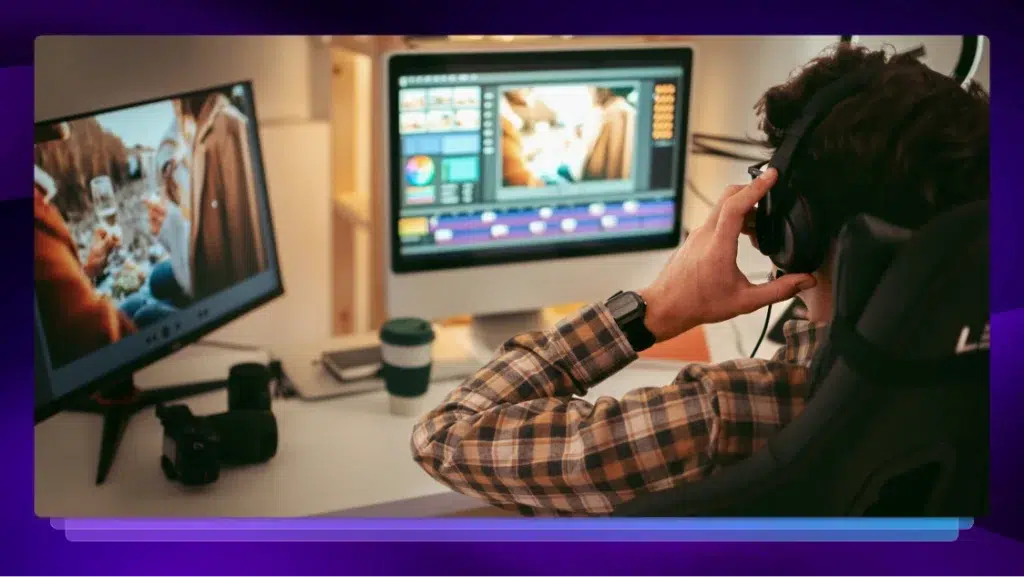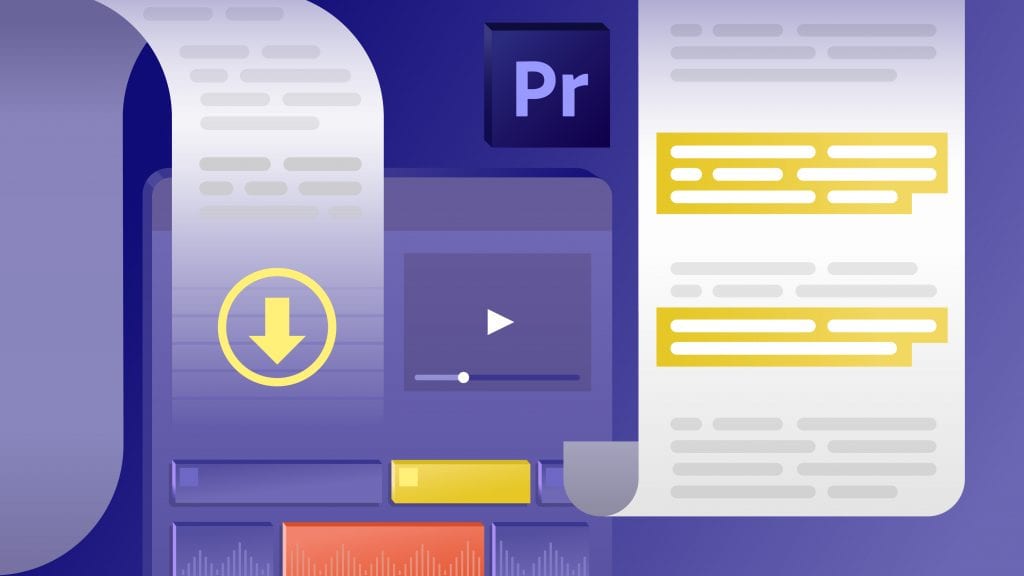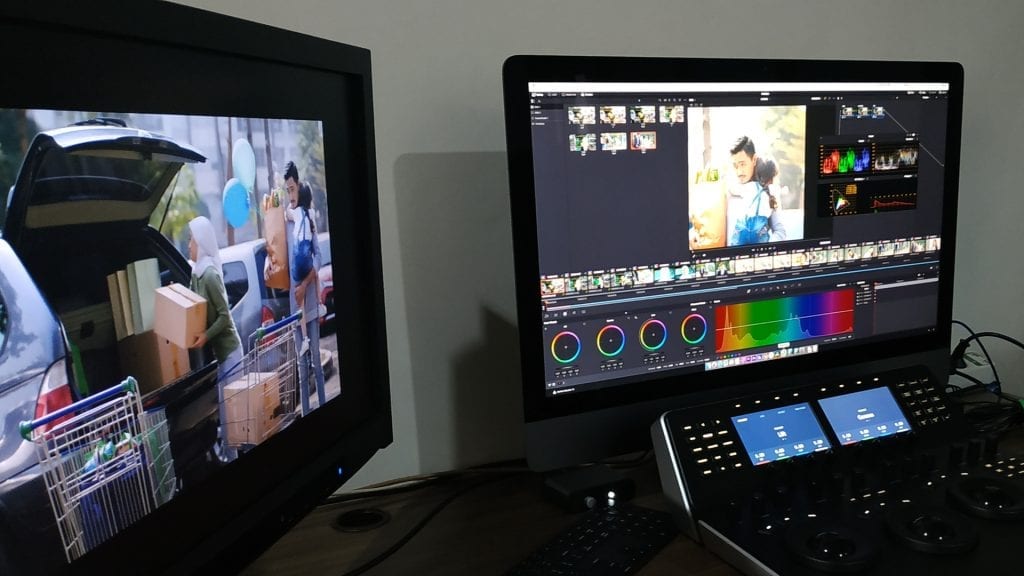The Best Video Editing Software for 2026
Make your job easier by choosing the best video editing software with Rev’s comprehensive breakdown of the best available options.

In today’s online, short-attention-span world, you need video content to thrive. A 2022 Cisco study showed that 82% of all online traffic came from video, proving that if you want to be seen, your content must include video in some form.
But a poor-quality video is almost worse than no video at all, so how do you ensure that the hard work you put into your plans, interviews, and video shoots pays off? Making a great-looking and sounding video, that’s how. This is why great video editing software is a must.
So how do you pick the best video editing software for your needs? To help you make the right decision for your unique needs, we’ve scoured the internet for “official” reviews and user feedback and combined it with our own experiences to offer the following suggestions. Happy deciding!
1. CyberLink PowerDirector 365
We’d describe CyberLink PowerDirector as professional video editing software for pros and non-pros alike. With loads of templates and AI options, even a novice can turn raw footage into professional-quality video. Meanwhile, experienced editors can use powerful tools like multicam editing and chroma-keying, as well as an intuitive interface to streamline their workflows without sacrificing video quality.
Our vote: Best overall video editing software

Price: $54.99 per year
Platform: PC, Mac
Best suited for: Pros and semi-pros
Our favorite feature: Wide variety of preloaded templates
Potential drawback: You’ll need a powerful computer because PowerDirector saps resources
Pros of CyberLink PowerDirector 365
- Stays up-to-date with support for new technology and formats
- Vast library of effects and tools
- Renders quickly
- Supports up to 100 video tracks
- No video length restrictions
Cons of CyberLink PowerDirector 365
- Requires heavy processing power
- Long export times for large projects
- Reported to crash more often than other software
- UI changes often due to frequent updates
2. CapCut
Are you new to video editing? Is your laptop a dinosaur? Do you do a lot of editing on your phone? If you’re looking for easy video editing software for social media or other simple formats, CapCut might be the application for you. With loads of built-in transitions, fonts, templates and a clever AI editor, CapCut is the choice for those who want a plug-and-play video editor that doesn’t skimp on features. It’s simple to export directly to most major social platforms, too.
Our vote: Best video editing software for beginners

Price: Free
Platform: Mac, Mobile
Best suited for: People new to video editing
Our favorite feature: AI editing
Potential drawback: Short max video length
Pros of CapCut
- Mobile friendly
- Intuitive and powerful editing capabilities
- Robust free version
- A deep library of stock audio options
- AI editing options
Cons of CapCut
- 15-minute maximum length
- One video track and one audio track per clip
- No motion tracking
- No 3D-video options
3. Da Vinci Resolve
From our research, the best free video editor is Blackmagic Design’s DaVinci Resolve. Though the free version is…well, free…it doesn’t feel like a trial version of a better, more expensive editing suite. It offers every tool you could reasonably ask for, an intuitive interface, and even a fairly robust audio editing package. For obvious reasons, we’re partial to its captioning and subtitling capabilities.
Our vote: Best free video editing software

Price: Free
Platform: PC, Mac
Best suited for: Editors with big projects but small budgets
Our favorite feature: Integrates with other softwares easily
Potential drawback: Not easy to learn
Pros of Da Vinci Resolve
- Full suite of editing tools for both video and audio
- Renders quickly
- Works well on Mac and PC
- Plays well with other editing tools
Cons of Da Vinci Resolve
- Can sap system resources
- Steep learning curve
- Fewer plug-ins than other leading softwares
4. Adobe Premiere Pro
Whether you love it or hate it, Adobe is widely considered the granddaddy of editing software for video and photos. Adobe Premiere Pro has a steep learning curve, but once you become comfortable with it (try these tips to help you edit better in Premiere), you can apply your experience to every product that comes with a subscription, which can include Photoshop and InDesign. It’s a one-stop shop for editing and creating from scratch. But be warned: it’s not for beginners, and it’s not cheap.
Our vote: Best comprehensive video editing software

Price: $400+ per year
Platform: PC, Mac, Mobile
Best suited for: Professional editors who do everything
Our favorite feature: Easily integrates with Adobe’s comprehensive suite
Potential drawback: Steep learning curve
Pros of Adobe Premiere Pro
- Industry-standard video editor
- Universally compatible
- A full suite of Adobe products makes almost any creative project possible
- Handles any file format in any size smoothly
Cons of Adobe Premiere Pro
- The complex interface has a steep learning curve
- Requires a robust computer system to run smoothly
- Subscription-based service is not cheap
5. Wondershare Filmora
Wonderhare Filmora is a straightforward application that gets the job done for less than $50 per year. It doesn’t offer all the bells and whistles of more robust editing tools like Adobe Premiere, but it does come with advanced options like AI-powered editing tools and motion tracking. A 12-month subscription is often less than the cost of a single month of other subs.
Our vote: Best low-budget editing software

Price: $49.99 per year
Platform: PC, Mac
Best suited for: Editors on a budget
Our favorite feature: Simple, intuitive interface
Potential drawback: Lack of advanced features
Pros of Wondershare Filmora
- Its simple interface makes it easy to use
- Renders quickly
- More bang for your buck
- AI options
Cons of Wondershare Filmora
- Features list isn’t as deep as pricier competitors
- Lags or crashes on many systems
- No multicam editing features
6. OpenShot
If you produce video content almost exclusively for YouTube, OpenShot’s streamlined set of features is geared toward your needs. It’s a free editing tool that doesn’t apply watermarks when exporting, doesn’t require a lot of processing power, and does offer a simple interface so new users can jump right in. Shoot, edit, and upload easily, especially if you’re on a tight budget.
Our vote: Best video editing software for YouTube

Price: Free
Platform: PC, Mac, Mobile
Best suited for: YouTubers
Our favorite feature: Works well, even if your computer’s processor is slow
Potential drawback: Some users complain of frequent crashes
Pros of Wondershare Filmora
- Its simple interface makes it easy to use
- Renders quickly
- More bang for your buck
- AI options
Cons of Wondershare Filmora
- Features list isn’t as deep as pricier competitors
- Lags or crashes on many systems
- No multicam editing features
7. Apple Final Cut Pro
If you’re a die-hard Mac user who happens to be a professional editor, Apple Final Cut Pro is for you. If you come from more PC-centric programs like Adobe Premiere Pro, you might find the switch to be lacking due to Final Cut’s very specific Apple interface. But if you’re a Mac person? This is the best video editing software. Reviewers love its stability, speed, and interface.
Our vote: Best video editing software for Mac users

Price: $299 one-time fee
Platform: Mac (with an iPad-specific version available)
Best suited for: Professional editors who use Macs
Our favorite feature: The one-time fee is a nice change from the usual subscription model
Potential drawback: Fewer features than its direct competitor, Adobe Premiere Pro
Pros of Apple Final Cut Pro
- Familiar Apple interface (if you’re into Apple products)
- One-time fee for desktop
- Not as “buggy” as other similar products
- Integrates with mobile version easily
Cons of Apple Final Cut Pro
- Timeline editor is confusing at first
- Importing and exporting are slower than others
- Doesn’t work well with non-Apple applications
8. Hitfilm Express
Hitfilm Express might have a daunting interface at first, but it also has a handy learning tool that walks beginners through the basics of film editing. It’s packed with tutorial videos that teach users everything from layers and masking to color correction. It’s a great “professional” option that doesn’t cost a dime, although some features will add a watermark unless you upgrade for a fee.
Our vote: Another great video editing software for newbs

Price: Free
Platform: PC, Mac
Best suited for: Beginners who want to go pro
Our favorite feature: Vast tutorial library
Potential drawback: Not the simplest interface
Pros of Hitfilm Express
- Nearly 200 effects
- Great tutorial videos
- Upgradeable, but for a cost
Cons of Hitfilm Express
- Not updated frequently
- Saps system resources
- Steep learning curve
9. Kapwing
Kapwing is a free, browser-based editing tool widely used by educators and collaborating teams. Its vast library of AI tools lets even the novice members of the team create high-end videos, gifs, and memes. As a web-based software, anyone on the team can log in and work on a shared project. One last perk is that it seems built with YouTube in mind, so it’s easy to create and export videos specifically for YouTube.
Our vote: Best for group editing

Price: Free
Platform: Web-based
Best suited for: Group projects
Our favorite feature: Works like a Google doc!
Potential drawback: It’s easy to hit the limits of the free version
Pros of Kapwing
- Great AI options
- Much easier to use in groups than installed software
- Template built specifically for YouTube
Cons of Kapwing
- Free version has limits on video length
- Light on more “professional” options like masking and multi-cam video
- Glitchy and crashes often
Video Editing Software: Common Questions
Even with the above suggestions, choosing a video editing software can be a daunting task. That’s why we’ve summarized a few frequently asked questions for you.
What’s the Top Free Video Editing Software?
The top free video editing software is Da Vinci Resolve. Calling any software the “top” in a category is a hard task, but for our money, it’s the best because its deep library of tools stands out among all free options. It’s also one of the only free softwares that doesn’t feel like a trial version.
What Do Most YouTubers Use to Edit Their Videos?
Most YouTubers use PowerDirector 365, OpenShot, and Kapwing when editing their videos, although with the huge selection of software available, there are quite a few “favorites.” A dive into Reddit threads proves that literally every software has a champion, and there’s no real consensus. As with every other choice, it’s more about your ability and the specific type of videos you make.
How Do I Know What Film Editing Software is Right For Me?
You know what film editing software is right for you when you realize that your specific job is easier when using it. There’s no “one-size-fits-all” answer here, though, so you have to do some research when looking for specific features that are right for you.
Ask yourself questions: Do you need a professional-grade editor but on little to no budget? Are you primarily creating for YouTube? Do you need to easily collaborate with others? Finding the answers to these questions will eventually lead you to the right software.
Once You’ve Chosen Your Software, Rev is Here to Help
Our primary goal at Rev is to streamline your workflow and help you produce the best possible videos. While we don’t offer our own video editing software, we’re a huge part of the video editing process, so we know a thing or two about what works and what doesn’t. Rev transcripts, subtitles, and captioning services streamline the editing process no matter what software you use.














